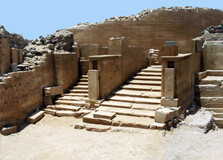
- Home
- Travel Packages
- Top Destination
-
Travel Attraction
By Category
Top Attraction

- Travel Agents
- Car Rentals
- Hotels

The Temple of Awwam, located near the ancient city of Marib in Yemen, is one of the most significant and iconic historical landmarks of the Sabaean Kingdom. The temple, dedicated to the moon god Almaqah, was a central religious and cultural hub in ancient times. Today, it stands as a powerful testament to the advanced architectural skills of the Sabaeans and is an important site for archaeologists and history enthusiasts interested in the ancient civilizations of the Arabian Peninsula. How to Reach the Temple of Awwam, Marib, Yemen To visit the Temple of Awwam, travelers typically start from the Yemeni capital, Sana'a. The temple is located around 120 kilometers (75 miles) east of Sana'a, near the modern-day city of Marib. The most common way to reach the temple is by car. The road connecting Sana'a to Marib is relatively direct, and the journey usually takes about two to three hours, depending on road conditions. While public transportation options exist, it is recommended to hire a private car or a local guide for a more comfortable and insightful trip. Weather in Marib Marib is located in a desert region, which means it experiences a hot climate year-round. During the summer months, temperatures can soar to above 40°C (104°F), with little to no rainfall. The cooler months, from November to February, offer more pleasant weather, with temperatures ranging from 20°C (68°F) to 25°C (77°F), making this the ideal time for visitors to explore the Temple of Awwam and other nearby sites. It is essential to carry plenty of water, wear sunscreen, and wear light, breathable clothing, especially if you plan to visit during the hot summer months. Timing of Visit The Temple of Awwam is an open-air archaeological site, so it is accessible to visitors throughout the year. However, the best time to visit is during the cooler months, from November to February, when temperatures are more bearable for outdoor exploration. The temple is usually open all day, and since it is not a heavily commercialized tourist site, there are no set hours of operation. Visitors should plan their visit during daylight hours to fully appreciate the ruins and surrounding landscape. Why the Temple of Awwam is Famous The Temple of Awwam is famous primarily for its religious and historical significance. Dedicated to the god Almaqah, the moon god of the Sabaeans, the temple was a center for religious rituals and ceremonies in ancient times. The Sabaean Kingdom, which flourished in the region from the 8th century BCE to the 3rd century CE, was one of the most prosperous civilizations of the Arabian Peninsula, and the Temple of Awwam was central to its culture. The temple is renowned for its stunning architectural design, which reflects the advanced construction techniques of the Sabaeans. The temple was built using large stone blocks, and while much of the structure has been damaged over the centuries, the ruins still offer a glimpse into the grandeur of the original design. The site also includes inscriptions and relics that provide insights into the Sabaean religion, culture, and language. Entry and Visit Details Visitors can access the Temple of Awwam by road, and there is no formal entrance fee to visit the site itself. However, there may be a small fee to visit nearby museums or archaeological sites in the region. Since the site is not heavily developed for tourism, it is highly recommended to visit with a local guide who can provide valuable information about the temple's history, architecture, and significance. Because the area around Marib has experienced political instability in recent years, travelers should always check the local security situation and any travel advisories before planning their visit. It is also a good idea to bring a local guide or security personnel to ensure a safe and informative experience. History and Architecture of the Temple of Awwam The Temple of Awwam dates back to around the 7th century BCE and is believed to have been built during the height of the Sabaean Kingdom. The Sabaeans, who inhabited the southern Arabian Peninsula, were known for their remarkable engineering and architectural skills, and the Temple of Awwam is one of the most impressive examples of their work. The temple was dedicated to Almaqah, the moon god, who was one of the most important deities in the Sabaean pantheon. The original structure of the temple was a large rectangular building, made of massive stone blocks, and it was likely surrounded by a courtyard and other religious structures. Today, the ruins include remnants of the temple's towering walls, columns, and gates. Inscriptions found at the site provide valuable insights into the Sabaean language and their religious practices. Although the temple suffered significant damage over the centuries due to natural disasters and human activity, including the Islamic expansion, much of the original structure remains, allowing archaeologists to study its architectural design and religious importance. The layout of the temple is a reflection of the Sabaeans' advanced understanding of geometry and construction techniques, which were ahead of their time. Things to Do Near the Temple of Awwam Aside from exploring the Temple of Awwam itself, there are several nearby attractions that visitors can enjoy: Marib Archaeological Museum: Located in the modern city of Marib, this museum houses a variety of artifacts from the Sabaean period, including pottery, inscriptions, and tools. It provides additional context for understanding the temple and the Sabaean civilization. The Ancient Marib Dam: Another significant historical site in the region, the ancient Marib Dam, was one of the largest and most advanced engineering feats of the ancient world. It helped transform the surrounding desert into fertile land for agriculture. Ruins of the Sabaean Kingdom: The city of Marib is home to many other archaeological sites that are linked to the ancient Sabaean Kingdom, including fortresses, residential areas, and royal palaces. Facts About the Temple of Awwam The Temple of Awwam is dedicated to Almaqah, the moon god, who was central to the religious practices of the Sabaeans. The temple was built during the 7th century BCE, and it served as a major religious and cultural center for the Sabaean Kingdom. The temple was constructed using massive stone blocks, showcasing the advanced architectural techniques of the Sabaean civilization. The temple is located near the ancient city of Marib, which was the capital of the Sabaean Kingdom and a hub of trade and culture in the Arabian Peninsula. Although much of the structure is in ruins today, the site is still an important archaeological and historical landmark. Tips for Visiting the Temple of Awwam Check security updates: Before traveling to Marib, check the latest security situation and travel advisories to ensure the area is safe for visitors. Hire a local guide: A knowledgeable local guide can provide a deeper understanding of the temple's history, significance, and the surrounding archaeological sites. Wear appropriate clothing: Marib's climate can be very hot, especially during the summer. Dress in light, breathable clothing and bring sun protection, such as sunscreen and a hat. Stay hydrated: The desert heat can be intense, so always carry enough water while exploring the site. Respect local customs: While visiting Yemen, it's important to be mindful of local customs and traditions, especially when interacting with the local people.
Explore More